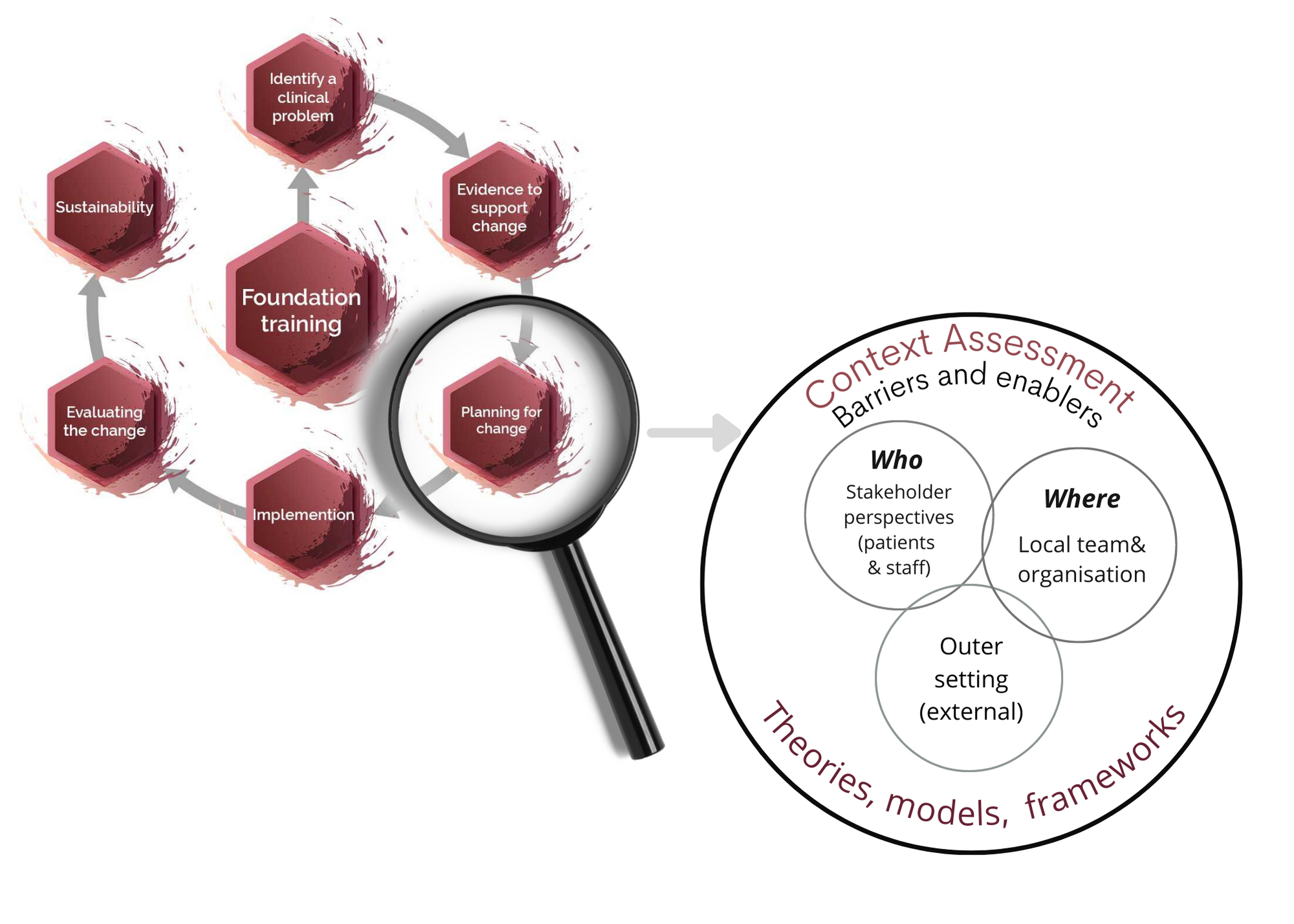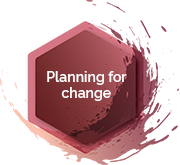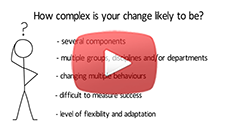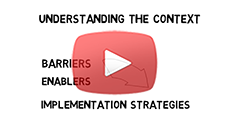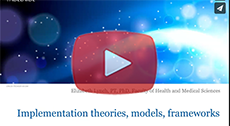Planning for change
Designing an evidenced based solution and planning for implementation is an important stage of planning – using a logic model or theory, model, or framework to understand the implementation context including barriers and enablers, strategies for change and who needs to do what differently for success is covered in this phase.
Before you move to planning, it is important you have:
(1) Identified a problem that an evidenced-based approach aims to tackle (i.e. an implementation gap)
(2) Conducted a review of the literature and evidence-base of the intervention(s) you have selected to address the identified problem
Stakeholders
When considering your TRIP project, it is not just the impact on you but also the range of stakeholders involved. It is important to identify and understand whether there is an impact on other individuals, teams, or organisations. Identification, selection and management of stakeholders can be tricky but do not underestimate their role. It is helpful to understand what ‘stake’ each stakeholder holds in the system to identify how you might best engage the different individuals, groups or organisations.
Webinar 2: Identifying and Engaging Stakeholders
Context Assessment
It is essential to understand the specific environment(s) where you will implement your intervention. Context affects implementation success, so it is important to understand what may unfold when your TRIP project and setting (e.g., team, department, or organisation) converge. It is important to note that context is distinct from the intervention and both will have their own set of characteristics that will need to be considered and managed. Is the specific context ready for this particular intervention? Does the intervention fit within the context? Finally, what are the barriers and enablers to making a change? Understanding this is key to selecting the right implementation strategies
Theories, models and frameworks
Using an implementation theory, model or framework helps ensure a sustainable change can occur by systematically thinking about a TRIP project and ensuring you understand the barriers and enablers to implementation to help guide the best strategies to for implementation. It is one of the key components to what sets TRIP apart from any other improvement or change project. A theory, model or framework allows you to explicitly consider all the different facets of a project - assisting you to understand or explain what influences your TRIP project and helping you to contextualise and evaluate your implementation outcomes.
Webinar 4: Choosing an implementation Theory, Model and Framework Dr Elizabeth Lynch
-
- Theory – Describes and explains WHY something happens
- Model – Describes and guides the process of TRIP
- Framework – Describes (but does not explain) the elements or factors that may influence WHY something happens
Implementation theories, frameworks and models can be used to:
- Describe or guide the process of translating research into practice (process models)
- Understand or explain what influences implementation outcomes (determinant frameworks, classic theories, and implementation theories)
- Evaluate implementation (evaluation frameworks)
-
“I would like to describe and/or guide the process…”
Process models or frameworks seek to describe and guide the TRIP process. Depending on what you select these will help you transfer findings from research to end-user, understand the context where the research will be implemented and used, or help guide the planning and execution of your TRIP project plan.
Knowledge to Action (KTA) Framework
- Webinars:
- Paper: Lost in Knowledge Translation: Time for a Map
- Book: Knowledge Translation in Health Care: Moving from Evidence to Practice
Exploration, Preparation, Implementation, Sustainment (EPIS) Model
- Webinar: Use of Theory in Implementation Research; The EPIS Framework: A Phased and Multilevel Approach to Implementation
- Website: https://episframework.com/
- Overview: The EPIS Model of Implementation
- Framework: The EPIS Framework
- Paper: Systematic review of the Exploration, Preparation, Implementation, Sustainment (EPIS) framework
- Paper: A model for Rigorously Applying the Exploration, Preparation, Implementation, Sustainment (EPIS) Framework in the Design and Measurement of a Large Scale Collaborative Multi-Site Study
Dynamic Sustainability
- Paper: Dynamic Sustainability Framework – Addressing the Paradox of ‘Sustainment’ Amid Ongoing Change
- Presentation: Dynamic Sustainability Framework – Addressing the Paradox of ‘Sustainment’ Amid Ongoing Change
Practical, Robust Implementation and Sustainability Model (PRISM)
- Summary: PRISM
- Paper: A Practical, Robust Implementation and Sustainability Model (PRISM) for Integrating Research Findings into Practice
- Paper: Using the Practical, Robust Implementation and Sustainability Model (PRISM) to Qualitatively Assess Multilevel Contextual Factors to Help Plan, Implement, Evaluate, and Disseminate Health Services Programs
Intervention Mapping (IM)
- Website: https://interventionmapping.com/
- Paper: Implementation Mapping: Using Intervention Mapping to Develop Implementation Strategies
Active Implementation Frameworks (AIF)
“I would like to understand and explain what influences implementation outcomes…”
Classic theories describe change mechanisms and how changes occur. These theories do not infer HOW to bring about change.
Theory of Reasoned Action/Theory of Planned Behaviour (best suited for interventions at the individual level)
Determinant Frameworks
Determinant frameworks describe what might influence an implementation outcome at an individual, organisational and/or societal level. Context is an integral component of all determinant frameworks.
Theoretical Domains Framework (TDF)
- Webinar: The Theoretical Domains Framework and Behaviour Change Wheel: An Introduction for Clinicians, A/Professor Shelley Wilkinson
- Paper: Making Psychological Theory Useful for Implementing Evidence Based Practice: A Consensus Approach
- Paper: A Guide to using the Theoretical Domains Framework of Behaviour Change to Investigate Implementation Problems
- Paper: Towards a Common Terminology: A Simplified Framework of Interventions to Promote and Integrate Evidence into Health Practices, Systems and Policies
Behaviour Change Wheel (adapted from COM-B)
- Webinar: The Theoretical Domains Framework and Behaviour Change Wheel: An Introduction for Clinicians, A/Professor Shelley Wilkinson
- Website: http://www.behaviourchangewheel.com/
- Book: The Behaviour Change Wheel – A Guide to Designing Interventions
- Paper: The Behaviour Change Wheel: A New Method for Characterising and Designing Behaviour Change Interventions
- Presentation: Designing Interventions using the Behaviour Change Wheel
Consolidated Framework for Implementation Research (CFIR)
- Webinar: A Guide to Consolidated Framework for Implementation Research (CFIR), Dr Jack Bell
- Website: https://cfirguide.org/
- Website: CFIR-ERIC Matching Tool – Helps ‘Match’ Strategies to Barriers Identified using the CFIR
- Paper: Fostering Implementation of Health Services Research Findings into Practice: A Consolidated Framework for Advancing Implementation Science
- Paper: The CFIR Card Game: A New Approach for Working with Implementation Teams to Identify Challenges and Strategies
Integrated-Promoting Action on Research Implementation (i-PARIHS)
Implementation Theories
Implementation theories facilitate ‘implementers’ to gain a better understanding and clarification of specific aspects of implementation.
Capability, Opportunity, Motivation and Behaviour Model (COM-B)
Can also be used as an evaluation framework
- Guide: A Guide on The COM-B Model of Behaviour
- Article: A Brief Introduction to the COM-B Model of Behaviour and the PRIME Theory of Motivation
- Article: The COM-B Model for Behaviour Change
Normalisation Process Theory (NPT)
Can also be used as an evaluation framework
Organisational Readiness for Change
“I would like to evaluate the implementation…”
Evaluation frameworks provide structure to evaluate the TRIP project. There are specific evaluation frameworks and other theories, models and frameworks that include measurable concepts and constructs (e.g. TDF, COM-B, NPT).
Reach, Effectiveness, Adoption, Implementation, Maintenance (RE-AIM)
- Webinar: An introduction to RE-AIM, Dr Michelle Cottrell
- Website: https://www.re-aim.org/about/what-is-re-aim/
- Paper: Evaluating the Impact of Health Promotion Programs: Using the RE-AIM Framework to Form Summary Measures for Decision Making involving Complex Issues
- Paper: Evaluating the Public Health Impact of Health Promotion Interventions: the RE-AIM Framework
PRECEDE-PROCEED
Implementation Outcomes Framework
Other resources
Champion Guide - Planning for change
This manual will provide a guide of how you can facilitate AH-TRIP training to use the AH-TRIP webinars and training materials. This guide will provide you with discussion points, prompts and concepts for you to consider and pose to your department or team to enhance learning opportunities. Read More > (PDF 186 kB)
